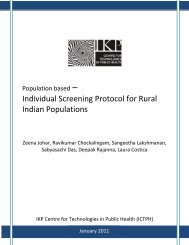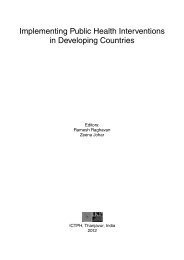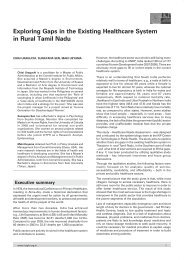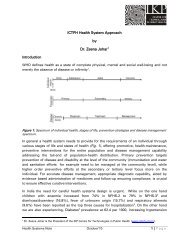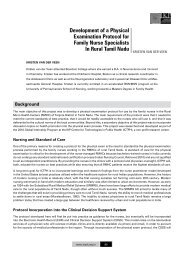Improving and Expanding Electronic Health Records in a Rural Setting
Improving and Expanding Electronic Health Records in a Rural Setting
Improving and Expanding Electronic Health Records in a Rural Setting
Create successful ePaper yourself
Turn your PDF publications into a flip-book with our unique Google optimized e-Paper software.
<strong>Improv<strong>in</strong>g</strong> <strong>and</strong> Exp<strong>and</strong><strong>in</strong>g <strong>Electronic</strong> <strong>Health</strong><br />
<strong>Records</strong> <strong>in</strong> a <strong>Rural</strong> Sett<strong>in</strong>g: Cl<strong>in</strong>ical Decision<br />
Support System & Public <strong>Health</strong> Component<br />
The decision-trees developed by ICTPH are <strong>in</strong> l<strong>in</strong>e with the SOAP consultation format used for patient visits at the cl<strong>in</strong>ics.<br />
The start<strong>in</strong>g po<strong>in</strong>t is a review of common symptoms a patient might be present<strong>in</strong>g (e.g. cough). The system then guides the<br />
nurse <strong>in</strong>to establish<strong>in</strong>g the nature of those symptoms by ask<strong>in</strong>g about the presence of certa<strong>in</strong> characteristics (e.g. site, onset,<br />
character, radiation, associated factors, time, reliev<strong>in</strong>g factors, <strong>and</strong> severity) based on a series of Yes/No questions. This <strong>in</strong><br />
turn, directs the nurse to review the relevant body systems to be exam<strong>in</strong>ed at the next stage, the physical exam (e.g. chest<br />
exam). Once that is completed, it is envisaged that the CDSS would deliver a set of probable diagnosis (e.g. tuberculosis,<br />
pneumonia), accompanied by a list of necessary lab tests (e.g. chest exam). The results of these labs tests are then fed back<br />
<strong>in</strong>to the system to yield a f<strong>in</strong>al diagnosis (e.g. pneumonia) (See Figure 2).<br />
The decision-trees developed by ICTPH will be made for a limited list of diseases that are a) most relevant to a rural sett<strong>in</strong>g,<br />
b) are reported as prevalent with<strong>in</strong> the community by the cl<strong>in</strong>ic physician <strong>and</strong> c) are able to be diagnosed at the primary<br />
care level. Diseases meet<strong>in</strong>g these criteria are grouped <strong>and</strong> classified by body systems (respiratory, cardiovascular, etc).<br />
The CDSS will only be able to diagnose this limited set of diseases, <strong>and</strong> it will recommend referrals for any disease that falls<br />
outside of its scope.<br />
EHR<br />
A similar methodology to that used for the creation of CDSS protocols was employed for develop<strong>in</strong>g protocols that identify<br />
<strong>in</strong>dividuals/communities at risk of develop<strong>in</strong>g diseases due to environmental conditions around them. The proposed start<strong>in</strong>g<br />
po<strong>in</strong>t for the <strong>in</strong>clusion of public health aspects is the collection of additional <strong>in</strong>formation regard<strong>in</strong>g <strong>in</strong>dividual patients <strong>and</strong><br />
community level data (Kukafja et al., 2007). It is important that needed data be collected at a s<strong>in</strong>gle time <strong>and</strong> then be reused<br />
rather than collected repeatedly by different users (Chute <strong>and</strong> Koo, 2002). If data is collected at multiple po<strong>in</strong>ts <strong>in</strong> time by<br />
different groups of people certa<strong>in</strong> amount of uniformity of data collection is lost. As a result it would become difficult to<br />
compare the <strong>in</strong>formation collected. By gather<strong>in</strong>g necessary data at a s<strong>in</strong>gle po<strong>in</strong>t <strong>in</strong> time by one group, <strong>in</strong>stances of data<br />
entry errors <strong>and</strong> confusions would be reduced.<br />
In order to gather appropriate data that would be easy to <strong>in</strong>put <strong>in</strong>to the EHR system, as well as easy to quantify, it is imperative<br />
to m<strong>in</strong>imize the <strong>in</strong>stances of open-ended questions. As such, decision trees (Annex #3 & #4) will be utilized that would take<br />
the user from various <strong>in</strong>dividual <strong>and</strong> community level environmental factors (i.e. cook<strong>in</strong>g/dr<strong>in</strong>k<strong>in</strong>g water, toilet use, trash<br />
policy, etc.), ultimately down to diseases <strong>in</strong>dividuals <strong>and</strong> communities would be at risk for. The environmental public health<br />
component will start with the water, waste system, sewage system, <strong>and</strong> <strong>in</strong>door air pollution factors. After a series of levels<br />
of questions, certa<strong>in</strong> comb<strong>in</strong>ations of results will ultimately lead the respondent household or community to be susceptible<br />
to gastro<strong>in</strong>test<strong>in</strong>al (GI) diseases <strong>and</strong> upper respiratory <strong>in</strong>fection (URI), the two health problems greatly affect<strong>in</strong>g Tamil Nadu<br />
rural populations (ICTPH Basel<strong>in</strong>e Epidemiological data, 2008).<br />
The decision tree is formed with the aid of multiple choice type questions, prompt<strong>in</strong>g the user to choose from a list of<br />
responses rang<strong>in</strong>g from simple yes/no options to more complex choices (i.e. regard<strong>in</strong>g cook<strong>in</strong>g practices: <strong>in</strong> the home,<br />
separate build<strong>in</strong>g, outdoors, or other). Certa<strong>in</strong> answers will ultimately lead down to an at-risk conclusion whereas others will<br />
not cause households or communities to be at risk for health problems. To be able to utilize these decision trees, two surveys<br />
were created (Annex #1 & #2), one developed to be adm<strong>in</strong>istered to communities <strong>and</strong> another to <strong>in</strong>dividuals. These surveys<br />
will essentially direct respondents through the decision tree, <strong>and</strong> will provide ICTPH with <strong>in</strong>formation that will enable the<br />
EHR system to quantify the results.<br />
The community-level survey was created with the <strong>in</strong>tention of hav<strong>in</strong>g the local government, <strong>and</strong>/or focus groups <strong>in</strong> the<br />
village as respondents. The community survey will identify problem areas <strong>in</strong> the hamlet (each village is divided <strong>in</strong>to a<br />
number of smaller regions called hamlets) (See Figure 3). This <strong>in</strong>formation will enable ICTPH the opportunity to see the<br />
most predom<strong>in</strong>ant environmental concerns <strong>in</strong> each hamlet that put their respective population at-risk for GI <strong>and</strong> URI.<br />
ICTPH will then be able to <strong>in</strong>tervene at the hamlet level to implement <strong>in</strong>itiatives that tackle these health concerns before<br />
symptoms arise.<br />
For example, an <strong>in</strong>itial question would be ask<strong>in</strong>g the hamlet where they receive their ma<strong>in</strong> source of dr<strong>in</strong>k<strong>in</strong>g water from:<br />
surface water, piped water <strong>in</strong> home/yard, outdoor community water pump, well, or other. If the respondent community<br />
answered surface water the decision tree would prompt them to a new series of questions <strong>and</strong> would then ask them if the<br />
surface water is used for any other purposes. Response choice to that question would be: Defecat<strong>in</strong>g, bath<strong>in</strong>g, wash<strong>in</strong>g<br />
www.ictph.org.<strong>in</strong> 23



